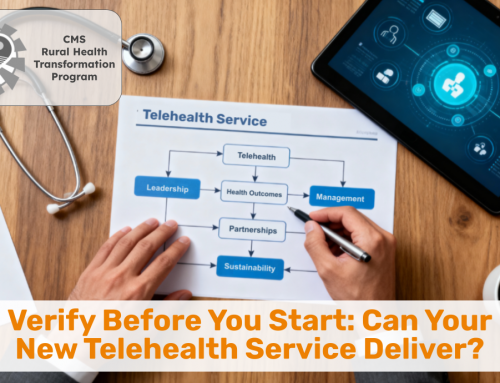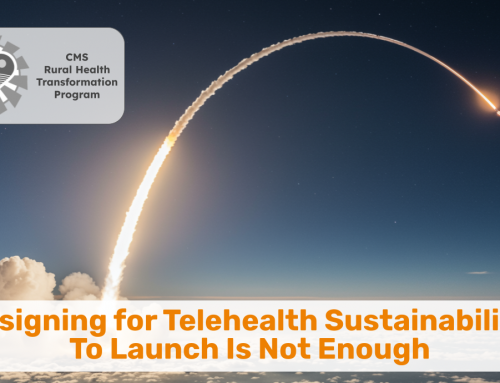Despite the accelerated adoption of telehealth during the COVID-19 pandemic, many clinicians — especially in community health centers, rural health clinics, or smaller rural health systems — continue to resist to use virtual care to improve access and continuity of care. While some clinicians have readily embraced telehealth as a viable care delivery modality, others remain skeptical or disengaged.
If you’re wondering why your clinicians (still) don’t like telehealth, here are five possible reasons that I (still) come across when we work with clients.
1. Lack of Leadership
Integrating telehealth is about changing the way that medicine is practice. Change has to start at the top, and when executive and medical leadership fail to embrace and support telehealth, resistance to telehealth is readily tolerated.
When healthcare leaders in 2025 are still dismissing telehealth as a temporary measure (using legislative uncertainty as an excuse) or if they assume it only appeals to younger, tech-savvy patients, they are missing the bigger picture and are missing out on the value and financial benefits.
The gap of those who do not embrace telehealth and large health systems’ and academic medical centers’ use of telehealth as a perfectly normal way to access care is widening, oftentimes leaving patients no choice but to go the “convenience route” with those who “get it”.
The Solution: Leadership must set a clear vision for telehealth. When used intelligently, telehealth will boost the bottom line, boost clinician and staff satisfaction, and lead to higher patient engagement. What’s not to like? Answering key questions such as “Why should our organization excel at telehealth?” and “What is our long-term telehealth strategy?” is crucial. Medical leaders, in particular, must advocate for and normalize telehealth adoption.
2. Poorly Defined Workflows
Technology often gets the blame for telehealth challenges, but the real issues are usually related to workflows (and the lack of support, see #4 below). A seamless patient experience requires well-coordinated steps — from scheduling and check-in to virtual “rooming” and follow-up.
Many organizations have not invested the time to create and train staff on standardized telehealth workflows, leading to confusion, miscommunication, and inefficiencies. Without well-defined processes, clinicians are left frustrated and disengaged.
The Solution: Map out and refine telehealth workflows for every virtual care service you offer. Train all staff members on their roles and responsibilities to ensure a smooth, predictable telehealth experience.
3. Frustrating Technology
While telehealth is not primarily about technology, the wrong tech choices can make or break clinician adoption. Many telehealth platforms were selected hastily during the pandemic, often dictated by IT departments or EHR vendors without clinician input. Unfortunately, EHR-based telehealth solutions frequently prioritize billing accuracy over usability, resulting in clunky, inefficient experiences, especially for patients.
The Solution: Don’t put the horse behind the cart and first decide on a new technology. Rather, involve clinicians, the actual users, in the technology selection process. This is not an IT decision alone. Define desired workflows and patient experiences before evaluating vendors. Provide hands-on training so clinicians feel confident using the platform rather than struggling through technical difficulties.



4. Lack of Competence & Confidence
Clinicians are highly skilled professionals who take pride in their expertise.
However, telehealth requires a different skill set, from mastering “webside manners” to diagnosing patients remotely without traditional physical assessments. Many clinicians feel uncomfortable with virtual care simply because they haven’t been adequately trained.
For professionals accustomed to being in control of their environment, the unpredictability of telehealth — such as poor video quality or patients struggling with technology — can be unnerving. Rather than risk feeling incompetent, some clinicians opt out of telehealth altogether.
The Solution: Provide structured training on virtual communication, remote examination techniques, and troubleshooting common telehealth issues. Confidence comes with competence, and competence comes with proper education and experience.
5. Ill-prepared Patients
Over the past decades patients have been conditioned to navigate in-person care: arrive, check in, wait, and see the doctor (and maybe pick up a magazine or a germ while you wait).
Virtual care requires a different set of expectations, yet many patients are unfamiliar with the process or lack digital literacy. When patients struggle with logging in, managing device settings, or following virtual visit protocols, it creates frustration for both them and the clinician.
The Solution: Implement “Telehealth TechChecks” — pre-visit sessions to help patients prepare for their appointments. Clearly communicate expectations for virtual visits and provide simple troubleshooting guides to reduce clinician frustration.
Helping Clinicians Embrace Telehealth
Ultimately, clinicians will embrace telehealth when they feel competent using it and when it allows them to practice at the top of their license — focusing on patient care rather than technical issues.
The key to successful telehealth adoption lies in optimizing both the clinician and patient experience. By addressing leadership engagement, workflow design, technology usability, clinician training, and patient preparedness, healthcare organizations can create an environment where telehealth is not just tolerated but embraced.
Are you struggling with telehealth adoption in your organization? Schedule a consultation with Christian to analyze your specific challenges and develop a roadmap for success.








To receive articles like these in your Inbox every week, you can subscribe to Christian’s Telehealth Tuesday Newsletter.
Christian Milaster and his team optimize Telehealth Services for health systems and physician practices. Christian is the Founder and President of Ingenium Digital Health Advisors where he and his expert consortium partner with healthcare leaders to enable the delivery of extraordinary care.
Contact Christian by phone or text at 657-464-3648, via email, or video chat.






